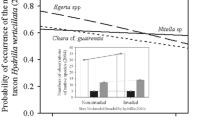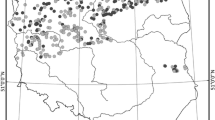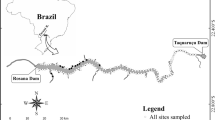Abstract
The Upper River Paraná Floodplain System comprises the rivers Ivinheima, Baía and Paraná, which with their associated waterbodies form three subsystems, each showing individual characteristics. Hydrilla verticillata recently invaded the Upper Paraná Floodplain, while Egeria najas is the native most abundant submersed macrophyte. A large flood-pulse, during January–March 2007, abruptly reduced macrophyte stands in many areas to near-zero and dispersed propagules over the entire floodplain. From April 2007 to April 2008, we conducted three surveys sampling for the presence–absence of H. verticillata and E. najas and environmental variables aiming to answer: (1) How rapid is the colonization–regeneration process for both species? (2) Which habitats seem to be more susceptible to their colonization? (3) Which environmental factors can best predict their occurrence? Neither H. verticillata nor E. najas colonized the Ivinheima subsystem. In the Baía subsystem, E. najas had only two occurrences while H. verticillata was not present. In the Paraná subsystem, E. najas predominantly occurred in river channels, but it was also common in floodplain lakes. In April 2007, it was found in 13% of the sites in the Paraná subsystem, increasing to 30% in November 2007 and reaching 34% in April 2008. H. verticillata did not successfully colonize floodplain lakes of the Paraná subsystem. In channels, it had 34% occurrence in April 2007, increasing to 62% in November 2007 and remaining at 62% in April 2008. The role of environmental variables in predicting species occurrence changed depending upon the scale of the analysis. Considering the whole Upper Paraná floodplain, water transparency followed by electrical conductivity were the strongest predictors for both species. Colonization by submersed plants seems improbable in the Ivinheima subsystem owing to its low water transparency besides frequent localized floods; in the Baía subsystem, it seems inhibited by transparency and low alkalinity. Considering just the Paraná subsystem, the proportion of organic matter in sediment, ten times higher in floodplain lakes than in channels, was the best predictor for H. verticillata occurrence (also related to water pH and transparency), while E. najas was only significantly explained by transparency.





Similar content being viewed by others
References
Agostinho, A. A., S. M. Thomaz & L. C. Gomes, 2004. Threats for biodiversity in the floodplain of the Upper Paraná River. Ecohydrology & Hydrobiology 4: 267–280.
Agostinho, A. A., S. M. Thomaz & L. C. Gomes, 2005. Conservation of the biodiversity of Brazil’s inland waters. Conservation Biology 19: 646–652.
Barko, J. W. & R. M. Smart, 1981. Comparative influences of light and temperature on the growth and metabolism of selected submersed freshwater macrophytes. Ecological Monographs 51: 219–235.
Barko, J. W. & R. M. Smart, 1983. Effects of organic matter additions to sediment of the growth of aquatic plants. Journal of Ecology 71: 161–175.
Barko, J. W. & R. M. Smart, 1986. Sediment-related mechanisms of growth limitation in submersed macrophytes. Ecology 67: 1328–1340.
Bini, L. M. & S. M. Thomaz, 2005. Prediction of Egeria najas and Egeria densa occurrence in a large subtropical reservoir (Itaipu Reservoir, Brazil-Paraguay). Aquatic Botany 83: 227–238.
Bowes, G., T. K. Van, L. A. Garrard & W. T. Haller, 1977. Adaptation to low light levels by Hydrilla. Journal of Aquatic Plant Management 15: 32–35.
Carmouze, J. P., 1994. O metabolismo dos ecossistemas aquáticos. Edgard Blücher/SBL/FABESP, São Paulo.
Chambers, P., P. Lacoul, K. J. Murphy & S. M. Thomaz, 2008. Aquatic macrophytes: world diversity and distribution. Hydrobiologia 595: 9–26.
Cook, C. D. K. & R. Lüönd, 1982. A revision of the genus Hydrilla (Hydrocharitaceae). Aquatic Botany 13: 485–504.
Cook, C. D. K. & K. Urmi-König, 1984. A revision of the genus Egeria (Hydrocharitaceae). Aquatic Botany 19: 73–96.
Figuerola, J. & A. J. Gree, 2002. Dispersal of aquatic organisms by waterbirds: a review of past research and priorities for future studies. Freshwater Biology 47: 483–494.
Golterman, H. L., R. S. Clymo & M. M. Ohmstad, 1978. Methods for physical and chemical analysis of fresh waters. Blackwell Scientific Publications, Oxford.
Haller, W. T. & D. L. Sutton, 1975. Community structure and competition between Hydrilla and Vallisneria. Journal of Aquatic Plant Management 13: 48–50.
Hershner, C. & K. J. Havens, 2008. Managing invasive aquatic plants in a changing system: strategic consideration of ecosystem services. Conservation Biology 22: 544–550.
Kahara, S. N. & J. E. Vermaat, 2003. The effect of alkalinity on photosynthesis-light curves and inorganic carbon extraction capacity of freshwater macrophytes. Aquatic Botany 75: 217–227.
Madsen, T. V. & K. Sand-Jensen, 1987. Photosynthetic capacity, bicarbonate affinity and growth of Elodea canadensis exposed to different concentrations of inorganic carbon. Oikos 50: 176–182.
Madsen, J. D. & D. H. Smith, 1999. Vegetative spread of dioecious Hydrilla colonies in experimental pounds. Journal of Aquatic Plant Management 37: 25–29.
Martins, D., N. V. Costa, M. A. Terra & S. R. Marchi, 2008. Characterization of the aquatic plant communities of 18 reservoirs of five watersheds in Sãol Paulo, Brazil. Planta Daninha 26: 17–32.
Mony, C., T. J. Koschnick, W. T. Haller & S. Muller, 2007. Competition between two invasive Hydrocharitaceae (Hydrilla verticillata L. f. and Egeria densa (Planch)) as influenced by sediment fertility and season. Aquatic Botany 86: 236–242.
Mullin, B. H., L. W. J. Anderson, J. M. DiTomaso, R. E. Eplee & K. D. Getsinger, 2000. Invasive plant species. CAST 13: 1–18.
Murphy, K. J., 1988. Aquatic weed problems and their management: a review – I. The worldwide scale of the aquatic weed problem. Crop Protection 7: 232–248.
Murphy, K. J. & A. H. Pieterse, 1990. Present status and prospects of integrated control of aquatic weeds. In Pieterse, A. H. & K. J. Murphy (eds), The Ecology and Management of Nuisance Aquatic Vegetation. Oxford Publications, New York: 222–227.
Murphy, K. J., G. Dickinson, S. M. Thomaz, L. M. Bini, K. Dick, K. Greaves, M. Kennedy, S. Livingstone, H. McFerran, J. Milne, J. Oldroyd & R. Wingfield, 2003. Aquatic plant communities and predictors of diversity in a sub-tropical river floodplain: the Upper Rio Paraná, Brazil. Aquatic Botany 77: 257–276.
Neiff, J. J., 1990. Ideas para la interpretacion ecologica del Paraná. Interciencia 15: 424–440.
Netherland, M. D., 1997. Turion ecology of Hydrilla. Journal of Aquatic Plant Management 35: 1–10.
Owens, C. S. & J. D. Madsen, 1998. Phenological studies of carbohydrate allocation in Hydrilla. Journal of Aquatic Plant Management 36: 40–44.
Pierini, S. A. & S. M. Thomaz, 2004. Effects of inorganic carbon source on photosynthetic rates of Egeria najas Planchon and Egeria densa Planchon (Hydrocharitaceae). Aquatic Botany 78: 135–146.
Rybicki, N. B., D. G. McFarland, H. A. Ruhl, J. T. Reel & J. W. Barko, 2001. Investigations of the availability and survival of submersed aquatic vegetation propagules in the Tidal Potamic River. Estuaries 24: 407–424.
Souza-Filho, E. E., E. Comunello & P. C. Rocha, 2004. Flood extension in the Baia-Curutuba-Ivinheima complex of the Paraná River Floodplain. In Agostinho, A. A., L. Rodrigues, L. C. Gomes, S. M. Thomaz & L. A. Miranda (eds), Structure and functioning of the Paraná River and its floodplain: LTER – Site 6 – (PELD – Sítio 6). EDUEM, Maringá: 19–24.
Spencer, W. E., J. Teeri & R. G. Wetzel, 1994. Acclimation of photosynthetic phenotype to environmental heterogeneity. Ecology 75: 301–314.
Tavechio, W. L. G. & S. M. Thomaz, 2003. Effects of light on the growth of Egeria najas Planchon. Brazilian Archives of Biology and Technology 46: 203–209.
Thomaz, S. M., L. M. Bini, T. A. Pagioro, K. J. Murphy, A. M. dos Santos & D. C. de Souza, 2004a. Aquatic macrophytes: diversity, biomass and decomposition. In Thomaz, S. M., A. A. Agostinho & N. S. Hahn (eds), The Upper Paraná River and its floodplain: physical aspects ecology and conservation. Backhuys Publishers, Leiden: 331–352.
Thomaz, S. M., T. A. Pagioro, L. M. Bini, M. C. Roberto & R. R. A. Rocha, 2004b. Limnology of the Upper Paraná Floodplain habitats: patterns of spatio-temporal variations and influence of the water levels. In Agostinho, A. A., L. Rodrigues, L. C. Gomes, S. M. Thomaz & L. A. Miranda (eds), Structure and functioning of the Paraná River and its floodplain: LTER – Site 6 – (PELD – Sítio 6). EDUEM, Maringá: 37–42.
Thomaz, S. M., T. A. Pagioro, L. M. Bini & K. J. Murphy, 2006. Effect of reservoir drawdown on biomass of three species of aquatic macrophytes in a large sub-tropical reservoir (Itaipu, Brazil). Hydrobiologia 570: 53–59.
Thomaz, S. M., L. M. Bini & R. L. Bozelli, 2007a. Floods increase similarity among aquatic habitats in river-floodplain systems. Hydrobiologia 579: 1–13.
Thomaz, S. M., P. A. Chambers, S. A. Pierini & G. Pereira, 2007b. Effects of phosphorus and nitrogen amendments on the growth of Egeria najas. Aquatic Botany 86: 191–196.
Van, T. K., W. T. Halle & G. Bowes, 1976. Comparison of the photosynthetic characteristics of three submersed aquatic plants. Plant Physiology 58: 761–768.
Van, T. K., G. S. Wheeler & T. D. Center, 1999. Competition between Hydrilla verticillata and Vallisneria americana as influenced by soil fertility. Aquatic Botany 62: 225–233.
Wang, J., D. Yu, W. Xiong & Y. Han, 2008. Above- and belowground competition between two submersed macrophytes. Hydrobiologia 607: 113–122.
Wetzel, R. G., 1983. Limnology. 2nd ed. Saunders College Publishing, Orlando: 767 pp.
White, A., J. B. Reiskind & G. Bowes, 1996. Dissolved inorganic carbon influences the photosynthetic responses of Hydrilla to photoinhibitory conditions. Aquatic Botany 53: 3–13.
Wingfield, R., K. J. Murphy & M. Gaywood, 2006. Assessing and predicting the success of Najas flexilis (Willd.) Rostk. & Schimidt, a rare European aquatic macrophyte in relation to lake environmental conditions. Hydrobiologia 570: 79–86.
Zagatto, E. A. G., A. O. Jacintho, B. F. Reis, F. J. Krug, H. Bergamin, L. C. Pessenda, R. J. Mortatti & M. F. Giné, 1981. Manual de análises de plantas empregando sistemas de injeção em fluxo. Universidade de São Paulo, Piracicaba. 45.
Acknowledgements
The first author thanks the Brazilian Council of Research (CNPq) and the Coordenadoria de Aperfeiçoamento de Pessoal de Nível Superior (CAPES) for funding his PhD course. We thank Agaito Barnabé and Sebastião Rodrigues for helping with the field work. Partial funds were provided by CNPq/MCT, through the Long Term Ecological Research Program (PELD, site number 6). S. M. Thomaz thanks the Brazilian Council of Research (CNPq) for ongoing funding through a Research Productivity Grant.
Author information
Authors and Affiliations
Corresponding author
Additional information
Handling editor: Luis Mauricio Bini
Rights and permissions
About this article
Cite this article
Sousa, W.T.Z., Thomaz, S.M., Murphy, K.J. et al. Environmental predictors of the occurrence of exotic Hydrilla verticillata (L.f.) Royle and native Egeria najas Planch. in a sub-tropical river floodplain: the Upper River Paraná, Brazil. Hydrobiologia 632, 65–78 (2009). https://doi.org/10.1007/s10750-009-9828-3
Received:
Revised:
Accepted:
Published:
Issue Date:
DOI: https://doi.org/10.1007/s10750-009-9828-3




